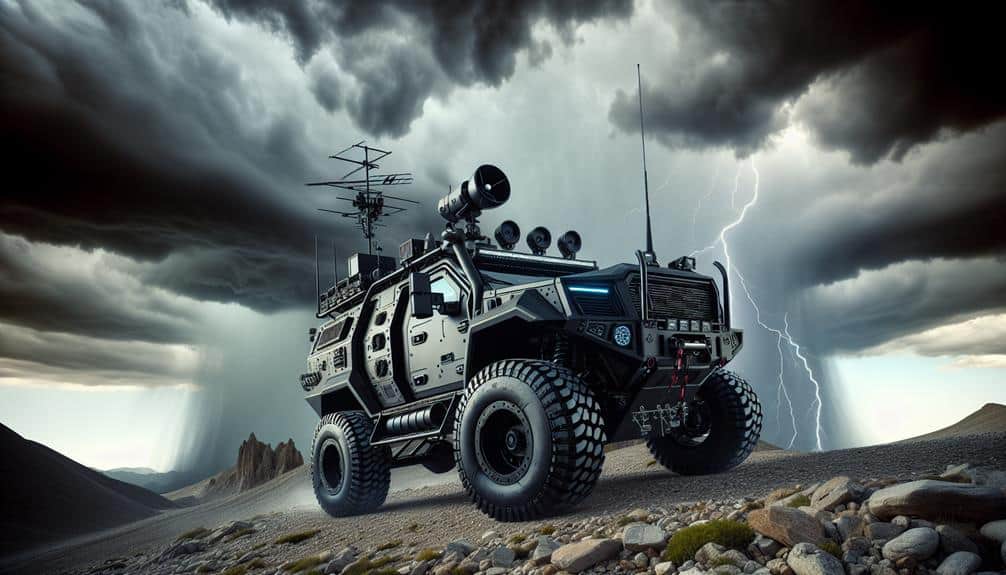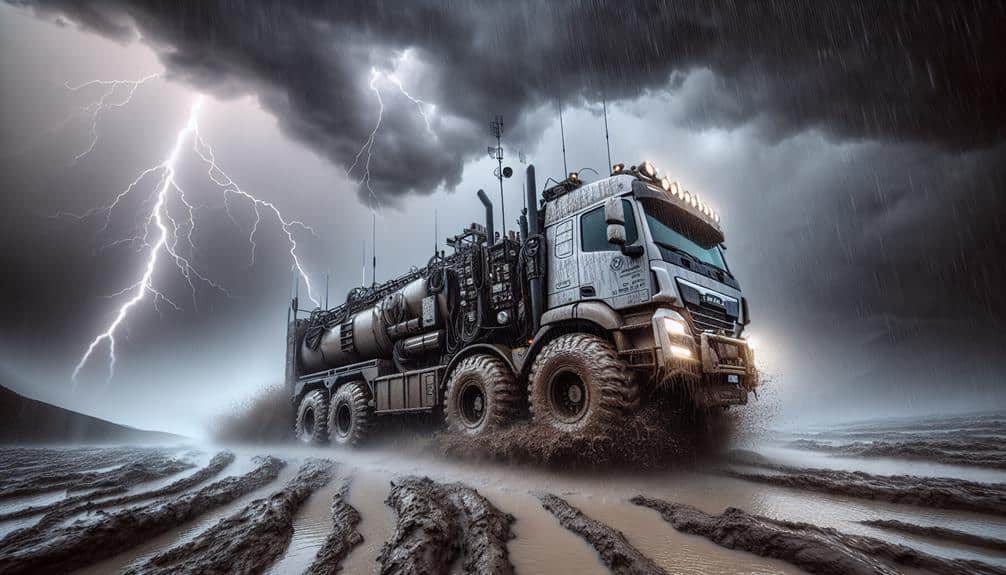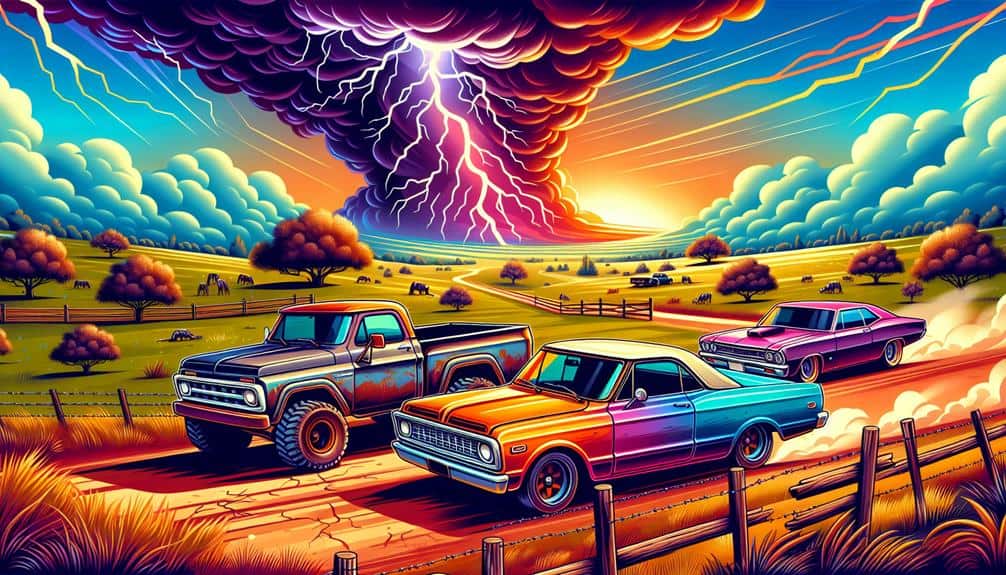In storm chasing, we outfit our vehicles with excellent safety features to tackle severe weather. Our reinforced vehicle structures, made with high-strength steel, guarantee structural integrity and impact resistance. High-traction tires, crafted from advanced rubber compounds with superior tread patterns, minimize hydroplaning risks. We utilize advanced weather radar for accurate storm tracking and real-time monitoring. Emergency communication systems and GPS tracking enhance coordination and safety. Additionally, roll cage installation and safety harnesses maintain occupant stability during high-velocity activities. These features collectively guarantee we navigate storms safely and effectively, allowing us to explore further advancements in storm chasing technology.
Key Points
- Reinforced Vehicle Structure: Advanced materials and crumple zones ensure structural integrity and energy absorption during crashes.
- High-Traction Tires: Superior tread patterns and advanced rubber compounds enhance grip and minimize hydroplaning on wet surfaces.
- Advanced Weather Radar: Real-time Doppler radar provides accurate storm tracking and severe weather prediction.
- Emergency Communication Systems: Satellite communication and emergency beacons ensure connectivity and coordination in remote areas.
Reinforced Vehicle Structure
One of the most important safety features in storm chasing vehicles is a reinforced vehicle structure designed to withstand high winds and debris impacts. We need this sturdy construction to guarantee that our vehicle can maintain structural integrity even in the most extreme weather conditions.
The reinforced framework enhances impact resistance and vehicle stability, essential for maneuvering through severe storms.
By integrating advanced materials such as high-strength steel and composite reinforcements, we greatly enhance crash protection. These materials are carefully chosen for their frame durability, ensuring that the vehicle can endure the destructive forces of flying debris and intense wind gusts without compromising the safety of its occupants.
Additionally, the reinforced vehicle structure is engineered with crumple zones strategically placed to absorb impact energy during a collision. This design minimizes the risk of injury by redirecting the force away from the passenger compartment.
We also incorporate roll cages to further enhance crash protection, providing a rigid safety cell that preserves vehicle stability during violent movements.
This meticulous attention to structural integrity ensures that we can confidently pursue our passion for storm chasing while prioritizing our safety and freedom. With these reinforced vehicle structures, we're empowered to explore the most formidable weather phenomena with peace of mind.
High-Traction Tires
Let's focus on high-traction tires, which are essential for storm chasing. These tires incorporate enhanced grip technology and weather-resistant materials to maintain stability in extreme conditions.
Additionally, their tread design efficiency optimizes water evacuation and maximizes surface contact, ensuring superior control.
Enhanced Grip Technology
Enhanced grip technology, particularly high-traction tires, plays a significant role in ensuring storm chasing vehicles maintain stability and control on wet and debris-laden roads. When we're out there facing the fury of nature, the last thing we need is to lose control of our vehicle. High-traction tires are engineered to provide improved handling and top-notch grip control, essential for maneuvering treacherous conditions.
For those of us who crave the freedom to chase storms, these tires offer several key benefits:
- Superior Tread Patterns: Designed to channel water away from the tire, minimizing hydroplaning risks.
- Advanced Rubber Compounds: Formulated to remain flexible at lower temperatures, enhancing grip on wet surfaces.
- Durability: Build to resist cuts and punctures from debris, ensuring longevity and reliability.
- Enhanced Sidewall Strength: Provides better resistance against impacts and sidewall cuts.
Weather-Resistant Materials
While high-grip tires greatly improve our vehicle's grasp and control, the materials they're made from must also withstand harsh weather conditions and constant exposure to moisture and debris. These tires are crafted from advanced rubber compounds that resist degradation from UV rays, temperature fluctuations, and chemical exposure. Such resilience is crucial for maintaining tire integrity amid relentless storm chasing.
In addition to robust tires, our vehicles feature waterproof electronics to guarantee uninterrupted functionality under severe weather. The integration of sealed connectors and weatherproof housings safeguards critical electronic systems from water ingress, reducing the risk of malfunctions that could compromise our safety.
Moreover, our interiors are designed to be mold resistant, using specialized materials that prevent fungal growth even in damp conditions. This is essential for maintaining a healthy environment inside the vehicle, especially during extended chases in humid or rainy climates.
The combination of high-grip tires, waterproof electronics, and mold resistant interiors exemplifies our dedication to durability and reliability. These features collectively enhance our ability to navigate treacherous terrains with confidence, giving us the freedom to pursue the most extreme weather phenomena safely and effectively.
Tread Design Efficiency
Our high-grip tires feature an innovative tread design that maximizes traction and stability on wet and uneven surfaces, guaranteeing top performance during intense storm conditions. By utilizing advanced rubber compounds and deep, multi-directional grooves, these tires offer outstanding water evacuation, reducing the risk of hydroplaning. The unique pattern also improves grip on loose gravel and mud, which are common in storm-affected areas.
Maintaining ideal tire pressure is essential for maximizing the efficiency of these high-grip tires. Properly inflated tires guarantee consistent contact with the road, enhancing both safety and fuel efficiency. Regular tire rotation is another important practice, as it promotes even wear and prolongs the lifespan of the tires.
Key features of our high-grip tires include:
- Advanced Rubber Compounds: Developed to enhance grip and durability.
- Deep, Multi-Directional Grooves: Engineered for excellent water evacuation and traction.
- Reinforced Sidewalls: Offer additional stability and puncture resistance.
- Enhanced Tread Patterns: Improve performance on both wet and dry surfaces.
Advanced Weather Radar

Utilizing advanced weather radar, we can accurately track storm movements and predict severe weather patterns with unprecedented precision. By integrating cutting-edge radar technology, our storm chasing vehicles are equipped for superior storm detection and weather tracking. This technology leverages Doppler radar, which measures the velocity and direction of storm particles, allowing us to monitor real-time developments and anticipate potential hazards.
The radar systems in our vehicles provide high-resolution data on precipitation intensity, storm cell structure, and rotation. This detailed information is essential for safety monitoring, enabling us to make informed decisions on positioning and movement, thereby maintaining a safe distance from the storm's most dangerous elements.
Our radar technology isn't just about storm detection; it's about empowering us with the freedom to navigate volatile weather. With precise weather tracking, we can identify the safest escape routes and react swiftly to changing conditions. The integration of dual-polarization radar further enhances our capability by differentiating between rain, hail, and debris, offering an additional layer of situational awareness.
Incorporating advanced weather radar in our storm chasing vehicles is a game-changer. It provides us with the data-driven insights needed to chase storms effectively while prioritizing our safety and operational efficiency.
Emergency Communication Systems
Effective emergency communication systems are essential for ensuring real-time coordination and safety during storm chasing operations. We need to stay connected and informed, especially when navigating through volatile weather conditions. Advanced communication technology allows us to relay information swiftly and accurately.
Here's what we rely on:
- Satellite communication: This technology guarantees we stay connected even in remote areas with no cellular coverage, providing a lifeline for data transmission and voice communication.
- Emergency beacons: These devices can send distress signals to emergency services, pinpointing our precise location if we're in trouble.
- GPS tracking: Real-time GPS tracking allows our team to monitor each vehicle's position, ensuring we can coordinate movements and assist each other effectively.
- Two-way radios: Reliable and easy-to-use, these radios allow for immediate communication between team members, vital for quick decision-making.
Roll Cage Installation
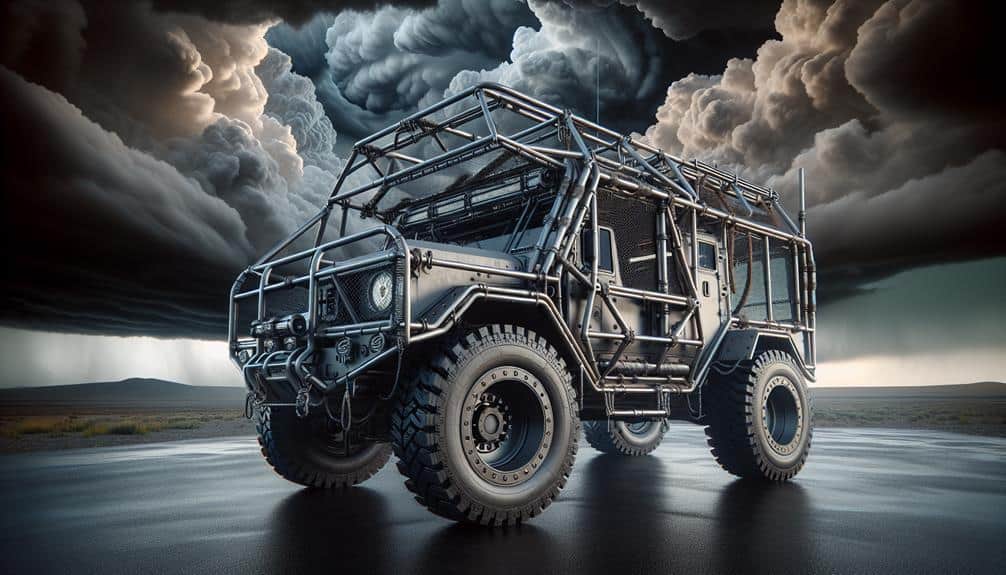
When we install roll cages in storm chasing vehicles, we enhance structural integrity, notably during rollovers. These cages, typically constructed from high-strength materials like chromoly steel, prioritize both durability and energy absorption.
Our design choices directly impact the effectiveness of these safety features, ensuring maximum protection for occupants in extreme conditions.
Structural Integrity Enhancement
Installing a roll cage greatly enhances the structural integrity of storm chasing vehicles, providing critical protection against rollovers and impacts. By reinforcing the vehicle's frame, we make sure it can withstand extreme forces, which is essential when handling severe weather conditions. A well-designed roll cage distributes impact forces more evenly, notably improving impact resistance and minimizing structural damage.
Here are some key features of roll cage installation that boost structural integrity:
- Material Strength: High-grade steel or chromoly tubing is used for its exceptional tensile strength and durability.
- Weld Quality: Precision welding techniques ensure strong joints that can handle high stress without failing.
- Design Optimization: Roll cages are designed to follow the contours of the vehicle, providing a snug fit that maximizes space and safety.
- Load Distribution: Properly installed roll cages distribute impact forces across a larger area, reducing concentrated stress points.
Protection During Rollovers
Enhancing protection during rollovers, roll cage installation ensures that the vehicle's occupants have a robust safety mechanism in place to withstand severe impacts. The roll cage improves roof strength, which is vital in maintaining the structural integrity of the vehicle during a rollover. This reinforcement minimizes the risk of roof collapse, safeguarding us from potential injuries.
We must pair roll cages with high-quality seat belts to maximize safety. In the event of a rollover, seat belts keep us securely in our seats, working in conjunction with the roll cage to reduce the risk of ejection. Additionally, modern storm chasing vehicles employ advanced airbags that deploy strategically to cushion and protect occupants during impact. These airbags, combined with a roll cage, provide a thorough safety net.
Stability control systems also play an important role. By preventing the vehicle from tipping over in the first place, stability control enhances the overall effectiveness of the roll cage.
When we equip our storm chasing vehicles with roll cages, we make certain that even in the most severe conditions, we've a reliable safeguard against rollovers, allowing us to chase storms with a greater sense of security and freedom.
Material and Design Choices
Selecting the best materials and design for roll cage installation is crucial to guaranteeing maximum durability and occupant protection in storm chasing vehicles. Our approach to vehicle modifications focuses on integrating safety innovations that can withstand the extreme forces encountered during severe weather events.
When it comes to roll cage materials, we prioritize high-strength, low-alloy (HSLA) steel due to its superior durability and weight efficiency. The design itself must distribute impact forces evenly to minimize deformation and protect occupants.
Key considerations include:
- Material Strength: HSLA steel provides an ideal balance of toughness and flexibility.
- Welding Techniques: TIG (Tungsten Inert Gas) welding guarantees strong and precise joints.
- Geometry: A well-designed roll cage features triangulated bars to effectively distribute loads.
- Padding: High-density foam padding reduces injury risk during impacts.
These elements not only enhance the vehicle's ability to withstand rollovers but also provide a layer of reassurance for those of us who chase storms.
Safety Harnesses and Seats
Safety harnesses and seats play an essential role in maintaining occupant stability and minimizing injury during high-velocity storm chasing activities. The effectiveness of seat belts in these scenarios can't be emphasized enough.
Adhering to thorough safety standards, our vehicles are equipped with multi-point harness systems that provide improved restraint and distribute forces more evenly across the body, thereby reducing the risk of injury.
Harness durability is another vital factor. We make certain that our harnesses are constructed from high-strength materials capable of withstanding significant stress. This durability is crucial for crash protection, as it ensures that the harnesses maintain their integrity under extreme conditions, such as those encountered during severe weather events.
Our seats are designed with ergonomic considerations and advanced impact-absorbing materials to further enhance safety. These seats work in harmony with the harness systems to provide all-encompassing protection.
By adhering to strict safety standards and utilizing advanced technology, we maximize seat belt effectiveness and harness durability, guaranteeing that we can focus on the freedom and exhilaration of storm chasing without compromising our safety.
In this manner, our safety harnesses and seats offer a blend of comfort, security, and reliability, making them essential components of our storm chasing vehicles.
Bulletproof Windows
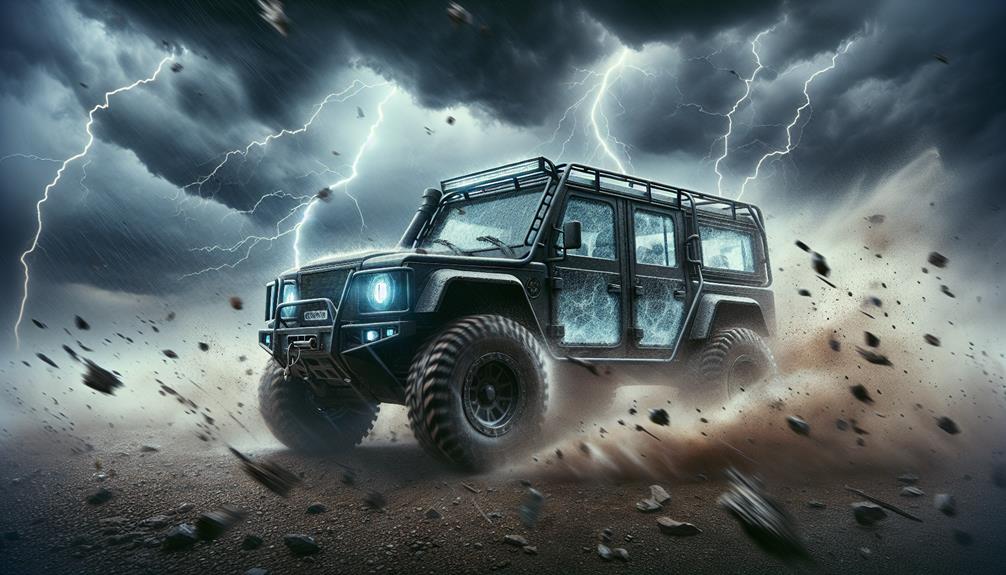
In order to protect against the extreme forces encountered during storm chasing, our vehicles are equipped with bulletproof windows that offer exceptional resistance to high-velocity debris and projectile impacts. These windows are critical for ensuring both our safety and the success of our missions.
Let's break down the key benefits:
- Window strength: Engineered to endure the most intense conditions, our windows are composed of multiple layers of polycarbonate and glass, providing outstanding robustness.
- Ballistic protection: These windows meet and often exceed ballistic standards, capable of withstanding impacts from flying debris at speeds exceeding 100 mph.
- Optical clarity: Despite their rugged build, our bulletproof windows maintain high optical clarity, ensuring that our visibility isn't compromised during critical moments.
- Heat resistance: The materials used in these windows also offer excellent thermal insulation, protecting us from extreme temperature variations associated with severe weather.
Frequently Asked Questions
What Qualifications Should a Storm Chasing Driver Have?
We can't relax our vigilance; storm chasing drivers need solid experience and rigorous training. They should understand meteorological data, vehicle dynamics, and safety protocols to navigate extreme weather conditions effectively and secure our freedom to explore safely.
How Do Storm Chasers Communicate With Local Authorities?
We use advanced communication systems to coordinate with local authorities for emergency response. Our weather monitoring tools provide real-time data, ensuring we relay accurate information to help manage severe weather situations effectively and maintain public safety.
What Are the Legal Regulations for Storm Chasing Vehicles?
We're discussing the legal regulations for storm chasing vehicles. Authorities mandate specific vehicle modifications and safety equipment, including reinforced exteriors and advanced communication systems, ensuring our freedom to chase storms while maintaining strict safety and compliance standards.
How Do Storm Chasers Stay Updated on Weather Changes?
We constantly check weather monitoring systems and technology updates to track storms. Real-time radar, satellite imagery, and meteorological models provide precise, timely data, ensuring we can chase safely and efficiently while embracing our passion for freedom.
Are There Specific Insurance Policies for Storm Chasing Vehicles?
Yes, there are specific insurance policies for storm chasing vehicles. These policies often include specialized insurance coverage options tailored for vehicle modifications and safety upgrades, ensuring we have the necessary protection while pursuing our freedom to chase storms.
